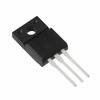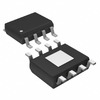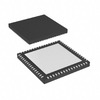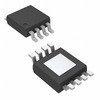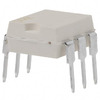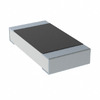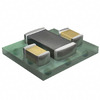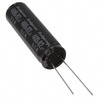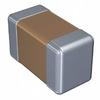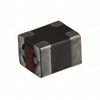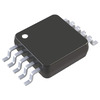From Audio Amplifiers to Frequency Oscillators: Analyzing 2N2222 and BC547 Transistors
2N2222 and BC547 are both NPN-type general-purpose low-power transistors, which are widely used in circuits such as audio amplifiers and frequency oscillators. In this article, we will compare both in terms of symbol, technical parameters, features, applications, and working principles.
Catalog
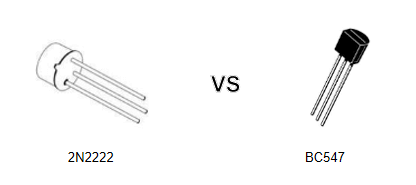
What is 2N2222?
The 2N2222 is a common NPN diode commonly used in low-power amplifiers and switching devices. It is designed for low to medium current, low power, medium voltage, and can operate at moderate high speeds. The main functional area of 2N2222 is packaged in TO-18 package. Compared with other small-sized transistors of the same type, its biggest feature is that it can withstand larger currents.
Typically, it can switch a load current of 800 mA, which is a much higher rating than other similar triodes. It consists of silicon or germanium material doped with positively or negatively charged materials. Its application can be either amplification of analog signals or switching applications. While performing amplification applications, it receives an analog signal through its collector and applies another signal at its base. The analog signal may be a speech signal with an analog frequency at 4 KHz (human voice).
Replacement and Equivalent
• 2N2222A
• 2N2222-BP
What is BC547?
The BC547 is a bipolar transistor composed of three different types of doped semiconductor materials and is commonly used in electronic circuits. It has three pins which are emitter, base and collector. When a voltage is applied to its base, it controls the flow of current from its emitter to its collector. This makes the triode BC547 an important part of many electronic circuits. This triode has a maximum gain current of 800 amps. In addition, the TO-92's packaging makes it easy to install and maintain on the board.
Replacement and Equivalent
• BC547BTA
• BC547CG
• BC547CZL1G
2N2222 vs BC547 Symbol
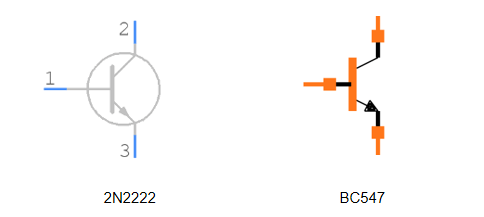
2N2222 vs BC547 Technical Parameters
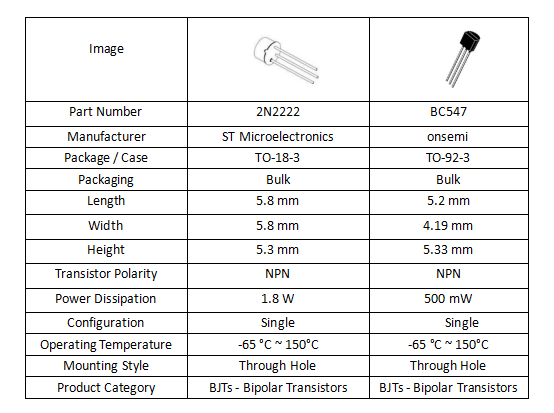
2N2222 vs BC547 Pin Comparison
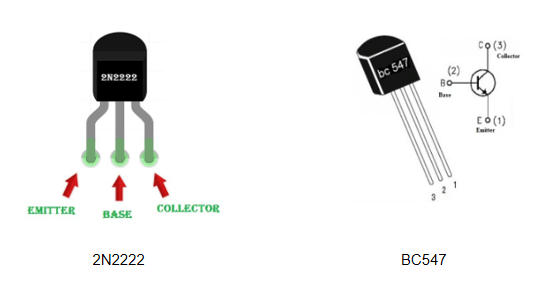
Collector: Current will flow through the collector terminal.
Base: This pin controls the transistor bias.
Emitter: Current is output through the emitter.
As shown in the picture above, the two transistors have different pin configurations. The first pin of the BC547 transistor is the collector, the second pin is the base, and the third pin is the emitter. The first pin of the 2N2222 transistor is the emitter, the second pin is the base, and the third pin is the collector. So we have to change the other side every time because the collector and emitter pins of the transistor are opposite each other.
2N2222 vs BC547 Features
2N2222
• The maximum capacity of processing frequency is 250MHz.
• The total power of the component should not exceed 500mw.
• The maximum tolerance between the base and collector terminals of 2N2222 is 60V.
• For a collector current of 10mA and a voltage of 10V, the DC current is approximately 75.
BC547
• Its characteristics are very stable and can work under different temperatures and voltages.
• Its noise figure is very low, which can reduce noise in electronic circuits.
• BC547 has a very high amplification factor and can amplify weak signals into observable signals.
• Due to the properties of its construction and materials, the BC547 can quickly switch circuits on and off, making it ideal for many electronic devices.
2N2222 vs BC547 Applications
The Application of 2N2222
• Computer Power Supply
• Thermostat
• Alarm System
• Light Modulator
• Audio Amplifier
• Motor Speed Controller
• RF Circuit
• Sensor Circuit
The Application of BC547
• Volume Indicator
• Based on Single Channel Relay Driver
• Alarm Circuit
• Water Level Indicator
• RF Circuit
• Transistor Darlington Pair
• PWM (Pulse Width Modulation)
• LED Flash Circuit
• Audio Preamplifier Circuit
• Corner Touch Switch
• Circuit Moisture-Sensitive Alarm Street Light Circuit
• LED Driver, Relay Driver and Other Drivers
Under What Circumstances Can 2N2222 and BC547 Not Be Used Interchangeably?
2N2222 and BC547 cannot be used interchangeably in the following scenarios.
The first is frequency response. BC547 has a good frequency response and is suitable for audio amplifiers and frequency fields. The 2N2222 is suitable for analog and digital circuits. If you need to process audio signals or perform frequency control, the BC547 may be more suitable.
The second is power amplification. 2N2222 is suitable for driving larger loads, such as a load current of 800mA, while the maximum collector current of BC547 is only 100mA. Therefore, if larger currents need to be handled, the BC547 may not replace the 2N2222.
2N2222 vs BC547 Working Principles
How Does 2N2222 Work?
The 2N2222 is an NPN transistor, which means its emitter is N-type material, its base is P-type material, and its collector is N-type material. When voltage is applied to the base, it forms an electron-hole pair, initiating control of the flow of current. When no voltage is applied to the base, the transistor is in a cut-off state, almost no current flows through it, and the current between the collector and emitter is close to zero.
When we apply a small current to the base, it causes current to flow between base-emitter. This current passes through the transistor and is amplified, resulting in a larger current flow between collector-emitter. This process allows the 2N2222 to amplify the input signal, so it is often used as a key part of the amplifier.
When the base current is large enough to bring the 2N2222 into saturation, the collector-emitter current will reach its maximum. At this time, it can be used as a switch to control other circuits or devices.
How Does BC547 Work?

When current enters the circuit, it is activated and the relay enters the open state. In this way, the base of the Q3 transistor is high across the entire R7 resistor to maintain the off state.
When the S2 switch opens, the Q4 transistor will start conducting and the relay 'L3' can latch. The base terminal of the Q3 transistor will be pulled low and then the L2 LED will flash to indicate power is on. The Q4 transistor conducts because transistor Q3 The collector terminal voltage uses resistor R8.
When switch S1 is pressed, the base of transistor Q3 will be pulled high and then L2 will turn off. This is because the base of the Q4 transistor is pulled down through the R8 resistor, causing relay L3 to close.
Frequently Asked Questions [FAQ]
1. What is the PNP of 2N2222?
The 2N2907 is the PNP complement to the 2N2222 when you need a PNP transistor of about the same (inverse) specifications.
2. How Much Power Can a 2N2222 Handle?
The 2N2222A transistor has a maximum collector-emitter voltage rating of 40V, which means it can handle a maximum voltage difference of 40V between the collector and emitter terminals.
3. What is BC547 Used For?
BC547 is usually used for current amplifier, quick switching, and pulse-width modulation (PWM). Therefore, if you need to control the speed of a motor or actuator in some of your projects, you can simply use this transistor to achieve it.
4. Can I Use 2N2222 Instead of BC547?
The 2N2222 and BC547 transistors are both general-purpose transistors that are frequently used in electrical circuits; the BC547 transistor is one of the best transistor equivalents for the 2N2222 transistor.
5. What is the Difference Between BC547 and 2N2222?
The 2N2222 and BC547 transistors are both general-purpose transistors that are frequently used in electrical circuits; the BC547 transistor is one of the best transistor equivalents for the 2N2222 transistor.
About us
ALLELCO LIMITED
Read more
Quick inquiry
Please send an inquiry, we will respond immediately.
→ Previous
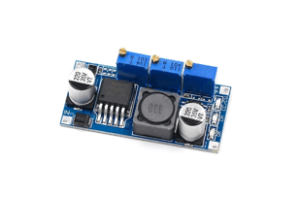
A voltage regulator is a power supply circuit or equipment that can automatically adjust the output voltage. It can stabilize the power supply voltage that fluctuates greatly or does not meet the requirements of electrical equipment within the set value range, enabling various circuits or electrical...

In this article we will explore the main differences between the L293D and L298N motor drivers. Both motor drives have their own unique features and applications. Understanding the difference between the two can help us better choose the appropriate motor control product. Let's take a look at the di...
→ Next

From Theory to Practice: Implementing the LM2596 Voltage Regulator in Your Projects
on April 29th

Choosing the Right Motor Driver: The Differences Between L293D and L298N Motor Drivers
on April 29th
Popular Posts
-

What is GND in the circuit?
on January 1th 3264
-

RJ-45 Connector Guide: RJ-45 Connector Color Codes, Wiring Schemes, R-J45 Applications, RJ-45 Datasheets
on January 1th 2812
-

Understanding Power Supply Voltages in Electronics VCC, VDD, VEE, VSS, and GND
on November 20th 2628
-

Fiber Connector Types: SC Vs LC And LC Vs MTP
on January 1th 2262
-

Comparison Between DB9 and RS232
on January 1th 1878
-

What Is An LR44 Battery?
Electricity, that ubiquitous force, quietly permeates every aspect of our daily lives, from trivial gadgets to life-threatening medical equipment, it plays a silent role. However, truly grasping this energy, especially how to store and efficiently output it, is no easy task. It is against this background that this article will focus on a type of coin cell battery that may seem insignificant on the...on January 1th 1840
-

Understanding the Fundamentals:Inductance Resistance, andCapacitance
In the intricate dance of electrical engineering, a trio of fundamental elements takes center stage: inductance, resistance, and capacitance. Each bears unique traits that dictate the dynamic rhythms of electronic circuits. Here, we embark on a journey to decipher the complexities of these components, to uncover their distinct roles and practical uses within the vast electrical orchestra. Inductan...on January 1th 1801
-

What Is RF and Why Do We Use It?
Radio Frequency (RF) technology is a key part of modern wireless communication, enabling data transmission over long distances without physical connections. This article delves into the basics of RF, explaining how electromagnetic radiation (EMR) makes RF communication possible. We will explore the principles of EMR, the creation and control of RF signals, and their wide-ranging uses. The article ...on January 1th 1793
-

CR2430 Battery Comprehensive Guide: Specifications, Applications and Comparison to CR2032 Batteries
What is CR2430 battery ?Benefits of CR2430 BatteriesNormCR2430 Battery ApplicationsCR2430 EquivalentCR2430 VS CR2032Battery CR2430 SizeWhat to look for when buying the CR2430 and equivalentsData Sheet PDFFrequently Asked Questions Batteries are the heart of small electronic devices. Among the many types available, coin cells play a crucial role, commonly found in calculators, remote controls, and ...on January 1th 1788
-

Comprehensive guide to hFE in transistors
Transistors are crucial components in modern electronic devices, enabling signal amplification and control. This article delves into the knowledge surrounding hFE, including how to select a transistor's hFE value, how to find hFE, and the gain of different types of transistors. Through our exploration of hFE, we gain a deeper understanding of how transistors work and their role in electronic circu...on November 20th 1777
